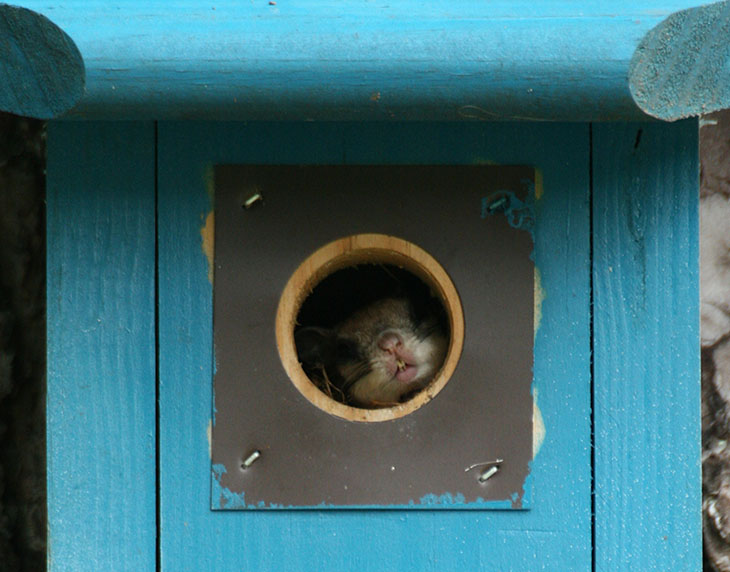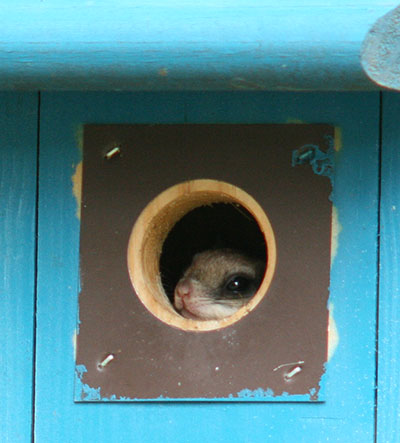While making my rounds in the yard today, looking for something of interest (mostly hemipterans for illustrative purposes,) I happened to glance up at the bluebird box which should, by all rights, be empty this time of year – with a lead-in like that, naturally, I saw something yank its head back inside. My glimpse was far too brief to tell me anything at all about the species, though it looked brown, and I was vaguely suspicious that it was a treefrog. I opened the box cautiously, but all I could see was a pile of newer nest material atop the older stuff, quivering gently; the box is enough above my head that I have to look up into it, and I decided not to poke my fingers in there and disturb the occupant, whatever it was. Instead, I attached a long lens to the camera and waited it out from a short distance away.
It didn’t take too long, except that when it did poke its head out, I still wasn’t sure what I was seeing. I was pretty sure it was a bird, definitely brownish, but I couldn’t make out any markings or even what way it was facing. As I circled around the box slowly, I started getting a look at a dark spot which I couldn’t place, suspecting it was a spot under the beak, but I was still confused.
Now, bear in mind my view was entirely through the viewfinder and not the cropped and enlarged image you’re about to see – abruptly, I knew what I was looking at, but it took a minute for it all to come together, largely because I was thinking along entirely different terms.

That… is the face of a southern flying squirrel (Glaucomys volans,) who decided that the bluebird box was an ideal nest. Flying squirrels are much smaller than the ubiquitous grey squirrels, about the size of a chipmunk, and have two breeding seasons per year at this latitude, spring and fall. Which means this is probably a female, and likely with a brood, or one soon to appear.
 To say I was delighted would be putting it mildly. While I’ve known for decades that they lived in this area, I’ve seen just one flying squirrel in the wild, and that was in downtown Savannah, Georgia, while we waited at dusk for the ghost tour to begin. Now, I’ve handled them while doing rehab, and even have a pair of images in the site gallery, but haven’t even come close to being able to photograph one in natural conditions. Until now, of course.
To say I was delighted would be putting it mildly. While I’ve known for decades that they lived in this area, I’ve seen just one flying squirrel in the wild, and that was in downtown Savannah, Georgia, while we waited at dusk for the ghost tour to begin. Now, I’ve handled them while doing rehab, and even have a pair of images in the site gallery, but haven’t even come close to being able to photograph one in natural conditions. Until now, of course.
The main reasons for this are that flying squirrels are nocturnal, and spend most of their time in the tree canopies, usually nesting in natural hollows (though I still have negatives around here somewhere of a squirrel brood that was being raised in an old hornet’s nest, brought in to the animal shelter where I worked after it had come down in a storm.) So while she might be peeking out at me during the day, I knew that after sunset was when she would venture out. So I set up the camera on a tripod, with the Metz flash on a stand alongside, and waited at dusk.
It’s funny – I was just reflecting last night as I sorted through my stock images that I had too few pics of mammals, but this is hardly the stunning coincidence that it might seem since I do that about four times a year. When we moved here in late May, we brought along the bluebird boxes from the old place, but I never put them up because it was late in the nesting season and we had plenty of other things to do, so the one seen here came with the house (thus you can’t credit me with that paint job.) It had even hosted a bluebird family for the late spring breeding season right after we moved in, but I have few pics of them. Now, of course, I’m going to have to put the others up, just in case.
After a couple of flash tests during setup, I spent over 30 minutes waiting for the squirrel to peek out again, with the intention of photographing her as she exited the nest box to do some nighttime foraging. I was sitting well away from the camera on the front steps, holding the wired remote release in my hand. Now, the camera will time out and shut down after a few minutes to conserve battery power, as will the flash unit. However, the camera will awaken instantly on being triggered by the remote; the flash will not. Thus when she peeked out for a few seconds, then swarmed out of the nest, paused on the front of the box, and scampered up over the roof and up the tree trunk, the flash failed to go off. So all I have right now is this image from the flash tests, while I switch over to the studio monolight for further attempts.

I can’t leave everything set up in the yard, so this will be all about timing, hoping to be set up and ready when she (or the newly emerged chillun) ventures out again. We’ll just have to see what happens.




















































